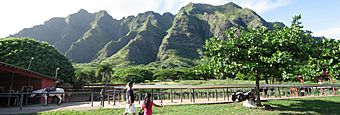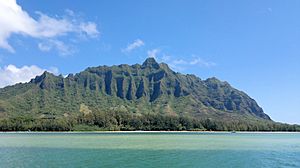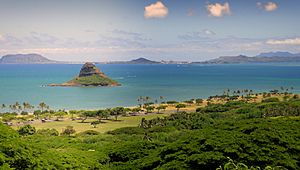Kualoa Ranch facts for kids
Quick facts for kids |
|
|
Kualoa Ahupua'a Historical District
|
|

Near the visitor center at Kualoa Ranch
|
|
| Nearest city | Kaneohe, Hawaii |
|---|---|
| Area | 4,000 acres (1,600 ha) |
| NRHP reference No. | 74000718 |
| Added to NRHP | October 16, 1974 |
Kualoa is a huge, beautiful private nature reserve and working cattle ranch on the windward (east) coast of Oʻahu, Hawaiʻi. It covers about 4,000 acres! This amazing place is also a very popular spot for visitors and a famous location for filming movies and TV shows. It's about 24 miles from Waikiki. The ranch includes three main valleys: Kaʻaʻawa Valley, Kualoa Valley, and Hakipuʻu Valley. You can find Kualoa on Hawaii State Route 83 between [[Kaʻaʻawa, Hawaii|Kaʻaʻawa]] and Waikane.
Contents
Kualoa's Rich History
Kualoa has a very long and special history. For ancient Hawaiians, from the 1200s to the 1700s, this valley was considered a sacred place. A powerful chief named Laʻa-mai-kahiki lived here for a time. Kualoa was also home to important sacred drums and a special hill called Kauakahiakahoʻowaha. This hill was believed to be key to the power of the Kingdom of Oʻahu.
An old Hawaiian chant, the Kumulipo, tells a story about Kualoa. It says that Papa and Wakea, important figures in Hawaiian beliefs, buried their first child, Haloa, here. It's believed that the very first kalo (taro) plant grew from where Haloa was buried at Kualoa.
How Kualoa Became a Ranch
In 1850, an American doctor and missionary named Dr. Gerrit P. Judd bought 622 acres of land at Kualoa. He paid $1300 for it! He also bought the small island of [[Mokoliʻi]], which is just offshore. He bought these lands from King Kamehameha III. Dr. Judd was very important to the King because he was the first person to translate medical books into the Hawaiian language.
Later, in 1860, Dr. Judd bought even more land, adding another 2,200 acres. His son, Charles Judd, bought 1,188 more acres in 1880. Today, the Kualoa Ranch covers about 4,000 acres in total.
Sugar Farming and World War II
In 1863, Charles Judd and his brother-in-law, Samuel Gardner Wilder, tried to start a sugarcane plantation at the ranch. They even built a sugar mill. However, there wasn't enough rain for the sugar cane to grow well, so the mill closed in 1870. You can still see the ruins of the old sugar mill along Kamehameha Highway today.
During World War II in 1941, the U.S. military used the land. It became a place for planes called Kualoa Airfield. After the war ended, the ranch was given back to the Morgan family, who are descendants of Dr. Judd and still own it today.
On October 16, 1974, the entire ahupuaʻa (which is a traditional Hawaiian land division) of Kualoa was added to the National Register of Historic Places listings in Oahu. This means it's recognized as an important historical site.
From 1993 to 1998, Kualoa Ranch hosted a big rock festival called the Big Mele. It was the first major rock festival in Hawaii since the Diamond Head Crater Festivals in the 1970s.
Fun Activities at Kualoa
Kualoa is still a working cattle ranch today, managed by John Morgan. But it's also a fantastic place for visitors! You can take guided tours to explore the beautiful valleys and learn about the history. One popular way to see the ranch is by riding horses along its trails.
In 2018, the ranch even started raising shrimp! They made it available for visitors to enjoy as part of their lunch.
Kualoa in Movies and TV Shows
Kualoa Ranch is super famous for being a filming location. More than 200 movies and TV shows have been filmed here over the years! Its amazing landscapes make it perfect for all sorts of stories.
Some of the well-known movies filmed at Kualoa include:
- Jurassic Park
- Jurassic World
- Kong: Skull Island
- Jumanji
- Jumanji: Welcome to the Jungle
- Godzilla
- Pearl Harbor
- 50 First Dates
- Mighty Joe Young
- George of the Jungle
Many TV shows have also used Kualoa as a backdrop, such as:
- Hawaii Five-0
- Magnum P.I.
- Lost
- Fantasy Island
The "Secret Island" at Kualoa Ranch was even the Finish Line for The Amazing Race 20 in 2012. A few months later, it was also a "Pit Stop" for the French version of The Amazing Race.




